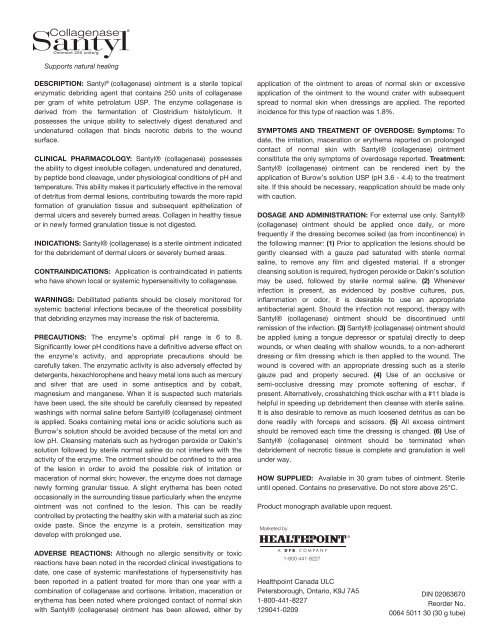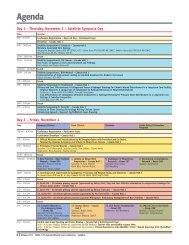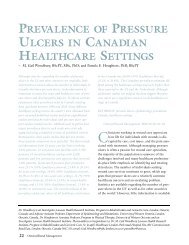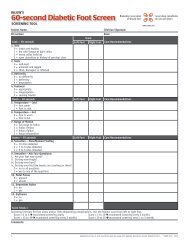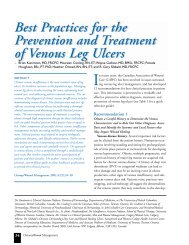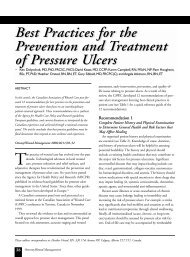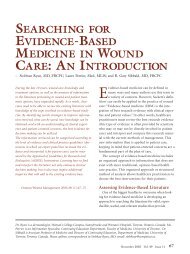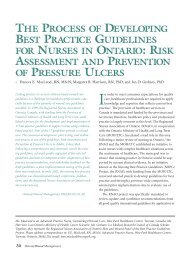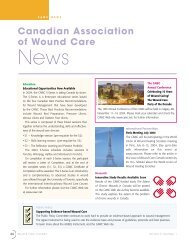Bilateral Lower Limb Lymphedema Secondary to Morbid Obesity
Bilateral Lower Limb Lymphedema Secondary to Morbid Obesity
Bilateral Lower Limb Lymphedema Secondary to Morbid Obesity
Create successful ePaper yourself
Turn your PDF publications into a flip-book with our unique Google optimized e-Paper software.
Supports natural healing<br />
DESCRIPTION: Santyl ® (collagenase) ointment is a sterile <strong>to</strong>pical<br />
enzymatic debriding agent that contains 250 units of collagenase<br />
per gram of white petrolatum USP. The enzyme collagenase is<br />
derived from the fermentation of Clostridium his<strong>to</strong>lyticum. It<br />
possesses the unique ability <strong>to</strong> selectively digest denatured and<br />
undenatured collagen that binds necrotic debris <strong>to</strong> the wound<br />
surface.<br />
CLINICAL PHARMACOLOGY: Santyl® (collagenase) possesses<br />
the ability <strong>to</strong> digest insoluble collagen, undenatured and denatured,<br />
by peptide bond cleavage, under physiological conditions of pH and<br />
temperature. This ability makes it particularly effective in the removal<br />
of detritus from dermal lesions, contributing <strong>to</strong>wards the more rapid<br />
formation of granulation tissue and subsequent epithelization of<br />
dermal ulcers and severely burned areas. Collagen in healthy tissue<br />
or in newly formed granulation tissue is not digested.<br />
INDICATIONS: Santyl® (collagenase) is a sterile ointment indicated<br />
for the debridement of dermal ulcers or severely burned areas.<br />
CONTRAINDICATIONS: Application is contraindicated in patients<br />
who have shown local or systemic hypersensitivity <strong>to</strong> collagenase.<br />
WARNINGS: Debilitated patients should be closely moni<strong>to</strong>red for<br />
systemic bacterial infections because of the theoretical possibility<br />
that debriding enzymes may increase the risk of bacteremia.<br />
PRECAUTIONS: The enzyme’s optimal pH range is 6 <strong>to</strong> 8.<br />
Significantly lower pH conditions have a definitive adverse effect on<br />
the enzyme’s activity, and appropriate precautions should be<br />
carefully taken. The enzymatic activity is also adversely effected by<br />
detergents, hexachlorophene and heavy metal ions such as mercury<br />
and silver that are used in some antiseptics and by cobalt,<br />
magnesium and manganese. When it is suspected such materials<br />
have been used, the site should be carefully cleansed by repeated<br />
washings with normal saline before Santyl® (collagenase) ointment<br />
is applied. Soaks containing metal ions or acidic solutions such as<br />
Burrow’s solution should be avoided because of the metal ion and<br />
low pH. Cleansing materials such as hydrogen peroxide or Dakin’s<br />
solution followed by sterile normal saline do not interfere with the<br />
activity of the enzyme. The ointment should be confined <strong>to</strong> the area<br />
of the lesion in order <strong>to</strong> avoid the possible risk of irritation or<br />
maceration of normal skin; however, the enzyme does not damage<br />
newly forming granular tissue. A slight erythema has been noted<br />
occasionally in the surrounding tissue particularly when the enzyme<br />
ointment was not confined <strong>to</strong> the lesion. This can be readily<br />
controlled by protecting the healthy skin with a material such as zinc<br />
oxide paste. Since the enzyme is a protein, sensitization may<br />
develop with prolonged use.<br />
ADVERSE REACTIONS: Although no allergic sensitivity or <strong>to</strong>xic<br />
reactions have been noted in the recorded clinical investigations <strong>to</strong><br />
date, one case of systemic manifestations of hypersensitivity has<br />
been reported in a patient treated for more than one year with a<br />
combination of collagenase and cortisone. Irritation, maceration or<br />
erythema has been noted where prolonged contact of normal skin<br />
with Santyl® (collagenase) ointment has been allowed, either by<br />
application of the ointment <strong>to</strong> areas of normal skin or excessive<br />
application of the ointment <strong>to</strong> the wound crater with subsequent<br />
spread <strong>to</strong> normal skin when dressings are applied. The reported<br />
incidence for this type of reaction was 1.8%.<br />
SYMPTOMS AND TREATMENT OF OVERDOSE: Symp<strong>to</strong>ms: To<br />
date, the irritation, maceration or erythema reported on prolonged<br />
contact of normal skin with Santyl® (collagenase) ointment<br />
consititute the only symp<strong>to</strong>ms of overdosage reported. Treatment:<br />
Santyl® (collagenase) ointment can be rendered inert by the<br />
application of Burow’s solution USP (pH 3.6 - 4.4) <strong>to</strong> the treatment<br />
site. If this should be necessary, reapplication should be made only<br />
with caution.<br />
DOSAGE AND ADMINISTRATION: For external use only. Santyl®<br />
(collagenase) ointment should be applied once daily, or more<br />
frequently if the dressing becomes soiled (as from incontinence) in<br />
the following manner: (1) Prior <strong>to</strong> application the lesions should be<br />
gently cleansed with a gauze pad saturated with sterile normal<br />
saline, <strong>to</strong> remove any film and digested material. If a stronger<br />
cleansing solution is required, hydrogen peroxide or Dakin’s solution<br />
may be used, followed by sterile normal saline. (2) Whenever<br />
infection is present, as evidenced by positive cultures, pus,<br />
inflammation or odor, it is desirable <strong>to</strong> use an appropriate<br />
antibacterial agent. Should the infection not respond, therapy with<br />
Santyl® (collagenase) ointment should be discontinued until<br />
remission of the infection. (3) Santyl® (collagenase) ointment should<br />
be applied (using a <strong>to</strong>ngue depressor or spatula) directly <strong>to</strong> deep<br />
wounds, or when dealing with shallow wounds, <strong>to</strong> a non-adherent<br />
dressing or film dressing which is then applied <strong>to</strong> the wound. The<br />
wound is covered with an appropriate dressing such as a sterile<br />
gauze pad and properly secured. (4) Use of an occlusive or<br />
semi-occlusive dressing may promote softening of eschar, if<br />
present. Alternatively, crosshatching thick eschar with a #11 blade is<br />
helpful in speeding up debridement then cleanse with sterile saline.<br />
It is also desirable <strong>to</strong> remove as much loosened detritus as can be<br />
done readily with forceps and scissors. (5) All excess ointment<br />
should be removed each time the dressing is changed. (6) Use of<br />
Santyl® (collagenase) ointment should be terminated when<br />
debridement of necrotic tissue is complete and granulation is well<br />
under way.<br />
HOW SUPPLIED: Available in 30 gram tubes of ointment. Sterile<br />
until opened. Contains no preservative. Do not s<strong>to</strong>re above 25°C.<br />
Product monograph available upon request.<br />
Marketed by<br />
1-800-441-8227<br />
Healthpoint Canada ULC<br />
Petersborough, Ontario, K9J 7A5<br />
1-800-441-8227<br />
129041-0209<br />
DIN 02063670<br />
Reorder No.<br />
0064 5011 30 (30 g tube)


